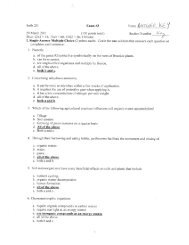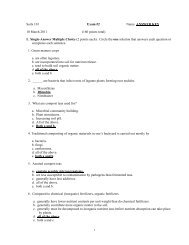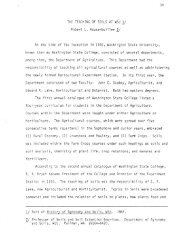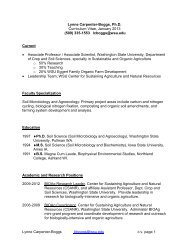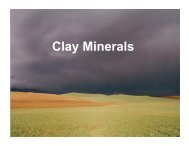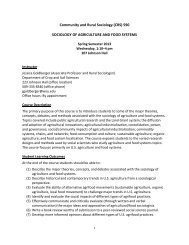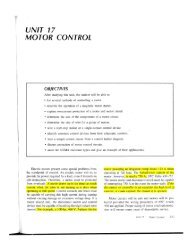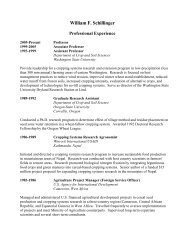2012 Dryland Field Day Abstracts - Dept. of Crop and Soil Sciences ...
2012 Dryland Field Day Abstracts - Dept. of Crop and Soil Sciences ...
2012 Dryland Field Day Abstracts - Dept. of Crop and Soil Sciences ...
You also want an ePaper? Increase the reach of your titles
YUMPU automatically turns print PDFs into web optimized ePapers that Google loves.
Part 4. bioenergy cropping systems research Page 55<br />
water.<br />
Another interesting data set from 2011 show that WW extracted 2.3 inches more water than WC by time <strong>of</strong> harvest. These soil<br />
water differences were highly significant statistically <strong>and</strong> apparent in all six replicates. Our previous experience had indicated that<br />
WC extracts more soil water than WW, but that was obviously not the case in 2011.<br />
Fig. 1. Grain yield <strong>of</strong> winter wheat (solid bars) versus<br />
winter canola (striped bars) in 2008, 2009, 2010, <strong>and</strong><br />
2011. Both crops were planted into no-till fallow on the<br />
Hal Johnson farm. Subsequent grain yield <strong>of</strong> spring<br />
wheat (solid white bars) grown after either winter wheat<br />
or winter canola is shown for 2009, 2010, <strong>and</strong> 2011.<br />
Camelina <strong>Crop</strong>ping Systems Experiment at Lind<br />
W.F. Schillinger, J.A. Jacobsen, S.E. Sch<strong>of</strong>stoll, <strong>and</strong> B.E. Sauer<br />
<strong>Dept</strong>. <strong>of</strong> <strong>Crop</strong> <strong>and</strong> <strong>Soil</strong> <strong>Sciences</strong>, WSU <strong>Dryl<strong>and</strong></strong> Research Station, Lind<br />
Fig. 2. WSU research technician in winter canola plot<br />
on the Hal Johnson farm NE <strong>of</strong> Davenport, WA<br />
A camelina cropping systems experiment was established at the WSU <strong>Dryl<strong>and</strong></strong> Research Station at Lind in the 2008 crop year. This<br />
experiment will be conducted for nine years to evaluate the traditional 2-year winter wheat-summer fallow (WW-SF) rotation with<br />
a 3-year winter wheat-camelina-summer fallow (WW-C-SF) rotation. Experimental design is a r<strong>and</strong>omized complete block with<br />
four replications. Each phase <strong>of</strong> both rotations appears each year in 30 ft x 250 ft plots (total = 20 plots). More than 90% <strong>of</strong> dry<br />
cropl<strong>and</strong> acres in the less than 12-inch annual precipitation zone are in WW-SF. The logical fit for camelina in this dry region is in a<br />
3-year WW-C-SF rotation.<br />
The experiment is located on a south-facing slope. <strong>Soil</strong>s on south-facing slopes are exposed to intense sunlight <strong>and</strong> drying, thus<br />
maintaining adequate seed-zone water content for deep-furrow planting <strong>of</strong> winter wheat can be a problem in dry years. <strong>Crop</strong>year<br />
(Sept. 1 – Aug. 31) precipitation was 6.85, 8.46, 11.58, <strong>and</strong> 11.70 inches in 2008, 2009, 2010, <strong>and</strong> 2011, respectively. Due to<br />
inadequate seed-zone water in late August <strong>of</strong> 2007 <strong>and</strong> 2008, we were unable to establish WW with deep-furrow planting into<br />
carryover moisture <strong>and</strong> instead planted WW in late October after the onset <strong>of</strong> fall rains. For this reason, combined with low cropyear<br />
precipitation, WW grain yields were low in 2008 <strong>and</strong> 2009 (Fig. 1).<br />
For the 2008, 2009, <strong>and</strong> 2010 crop years, camelina was planted in mid October. However, we learned from the camelina planting<br />
date <strong>and</strong> method experiment (also at the Lind Station, see related article in this booklet) that the best camelina seed yield<br />
potential appears to be from a late February-early March planting. A later planting date allows for application <strong>of</strong> glyphosate<br />
herbicide just before planting to control tumble mustard, tansy mustard, <strong>and</strong> flixweed; these broadleaf weeds establish during the<br />
fall <strong>and</strong> winter. For these reasons, we changed the planting date on or about March 1 beginning in 2011 (Fig. 2).<br />
Grain yields in both the WW-SF <strong>and</strong> WW-C-SF rotations are shown in Fig. 1. Average seed yield <strong>of</strong> camelina ranged from less than




